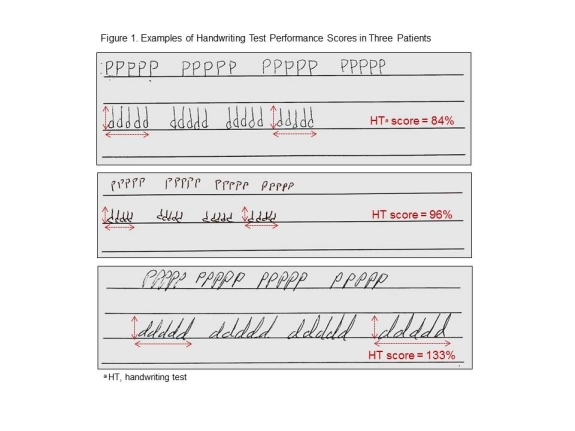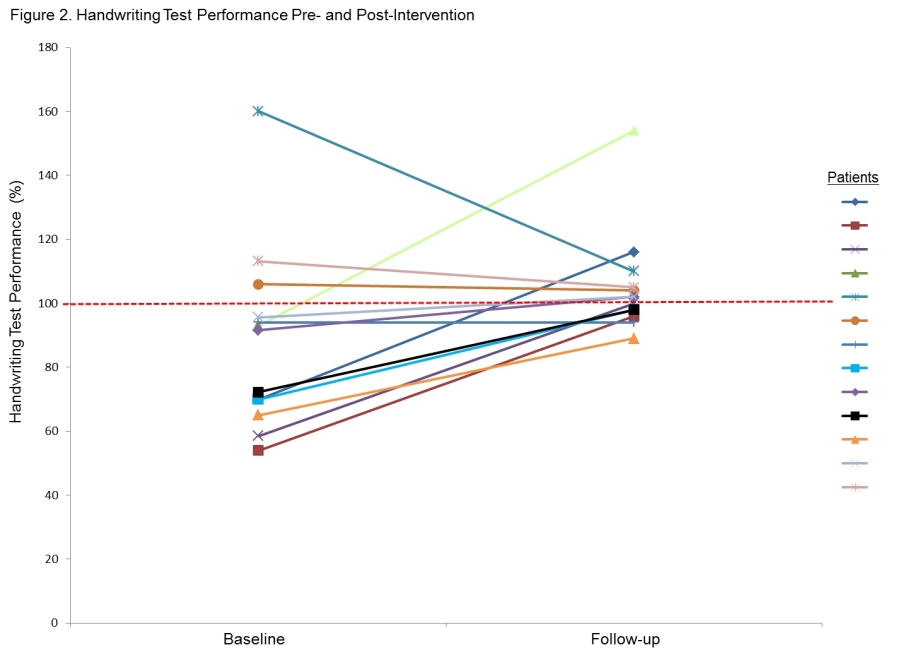Session Information
Date: Thursday, June 23, 2016
Session Title: Parkinson's disease: Clinical trials, pharmacology and treatment
Session Time: 12:00pm-1:30pm
Location: Exhibit Hall located in Hall B, Level 2
Objective: To observe changes in handwriting following administration of repetitive transcranial magnetic stimulation (rTMS) over pre-motor cortex (pre-MC) in patients with PD.
Background: Patients with PD often face challenges with handwriting. Micrographia is a common feature associated with PD, but recently the term “dysgraphia” has been proposed so as not to overlook the large spectrum of kinematic handwriting abnormalities observed in this population. Pre-MC is involved with motor execution and its broad anatomical and functional connections with the basal ganglia and motor cortex can be an important factor on handwriting kinematics. rTMS applied over the pre-MC has been shown to be an effective additive therapy for PD motor symptoms (Shirota et al, 2013). Therefore, pre-MC rTMS could have the potential to affect handwriting performance in PD.
Methods: Secondary analysis was done on data collected for a clinical trial administering rTMS over pre-MC to improve motor symptoms in PD (n=14). Patients’ history of micrographia was collected through directed interview and handwriting performance was assessed using a validated handwriting test (HT) (Shukla et al, 2012) at baseline and again 4 weeks post-treatment completion. HT scores reflect the area of the last block of “d”s compared to the first block of “d”s (figure 1).Patients are considered to have progressive micrographia if the area of the last block is less than 70% of the first (Shukla et al, 2012). All patients were assessed in their ON-states. 
Results: Thirteen subjects completed the HT during both visits. Eleven reported dysgraphia and 4 had objective progressive micrographia based on the validated HT. At baseline, median HT score was 91.6% (IQR 33.3%) and the coefficient of quartile variation (CQV) was 0.182. At follow-up, median HT score was 101.6% (IQR 11.0%) and CQV was 0.054, 3.4 times less variation compared to baseline. The subjects with objective micrographia normalized 4 weeks post-treatment. Graphic representation of HT scores at the two visits is shown in figure 2. 
Conclusions: Patients’ performances on the HT seem to converge towards normality (100%) following pre-MC rTMS. These findings suggest pre-MC rTMS neuromodulation could improve dysgraphia. Larger studies including healthy volunteers and a sham control group are required to provide further insight into this potential normalization effect.
To cite this abstract in AMA style:
A.Y. Son, M.C. Biagioni, E. Pirraglia, A. DiRocco. Changes in handwriting following repetitive transcranial magnetic stimulation over pre-motor cortex in Parkinson’s disease [abstract]. Mov Disord. 2016; 31 (suppl 2). https://www.mdsabstracts.org/abstract/changes-in-handwriting-following-repetitive-transcranial-magnetic-stimulation-over-pre-motor-cortex-in-parkinsons-disease/. Accessed October 17, 2025.« Back to 2016 International Congress
MDS Abstracts - https://www.mdsabstracts.org/abstract/changes-in-handwriting-following-repetitive-transcranial-magnetic-stimulation-over-pre-motor-cortex-in-parkinsons-disease/
